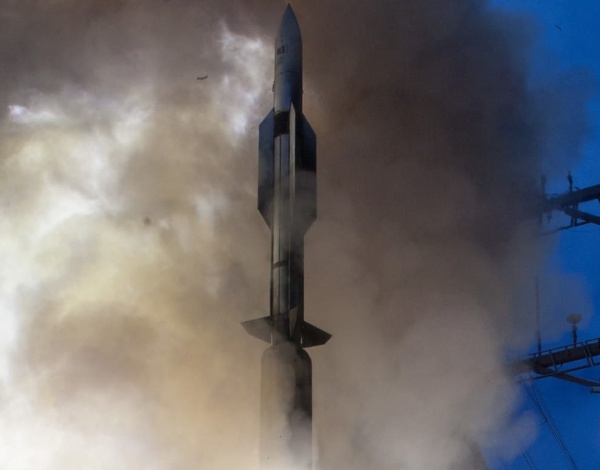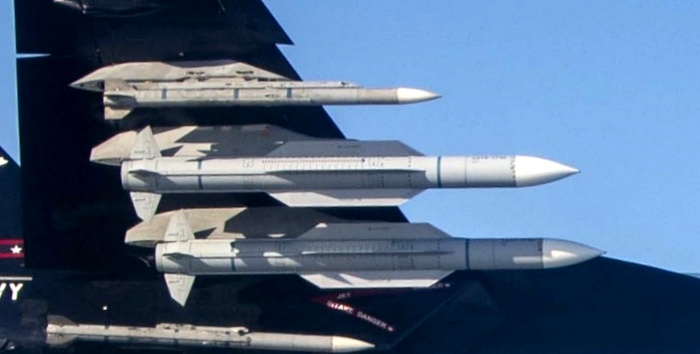Raytheon AIM/RIM-174 Standard SM-6 (original) (raw)
The U.S. Navy's RIM-156B SM-2 Block IV A TBMD (Theater Ballistic Missile Defense) missile was cancelled in December 2001. Because the RIM-156B was to have secondary AAW (Anti-Air Warfare) capability, this left a potential gap in the future long-range air defense assets of the Navy. Therefore the ERAM (Extended Range AAW Missile) program to study possible replacements for the SM-2 Block IV A was begun. The result was the Standard Missile 6 (SM-6), which is effectively anRIM-156A SM-2 Block IV missile, to which an active radar seeker derived from that of theAIM-120C-7 AMRAAM air-to-air missile has been added for terminal guidance. Because of that seeker, the ERAM acronym has since been redefined to mean Extended Range Active Missile. In February 2008, the SM-6 was officially designated as RIM-174A.
 |
|---|
| Image: Raytheon |
| RIM-174A |
In September 2004, Raytheon received a development contract for a 7-year SDD (System Development & Demonstration) phase of the SM-6. In June 2008, the first successful intercept of a drone by an RIM-174A missile occurred, and in September 2009, Raytheon was awarded the first LRIP (Low Rate Initial Production) contract for the SM-6. Full-rate production was approved in May 2013, and IOC (Initial Operational Capability) of the RIM-174A was reached at the end of that year.
The RIM-174A is launched from MK 41 VLS (Vertical Launch System) tubes. After launch, the missile uses either semi-active radar guidance, when the target is illuminated by the ship's radar, or inertial guidance in over-the-horizon shots. The missile's active radar seeker takes over as soon as it can identify and track the target. The 64 kg (140 lb) blast-fragmentation warhead is detonated by a proximity fuze. The primary mission of the RIM-174A is anti-air warfare, against manned aircraft and cruise missiles. The effective range of the RIM-174A in that role is classified, but is generally reported to be at least 240 km (150 miles), and possibly as high as 460 km (285 miles). An important secondary role of the SM-6 is intercepting ballistic missiles in their terminal flight phase, thereby complementing the RIM-161 Standard SM-3 in the Aegis Ballistic Missile Defense (ABMD) system. This capability required an upgrade of the processing power both in the missile (then labeled SM-6 "Dual I") and the ship's Aegis Combat System.
 |
|---|
| Photo: Raytheon |
| RIM-174A |
In 2014, the Navy began the development of the RIM-174B SM-6 Block IA. The most important upgrade in that version is the addition of a GPS guidance system. This gives the missile an anti-surface warfare capability against ships and land targets. FOC (Full Operational Capability) of the RIM-174B with the U.S. Navy was reached at the end of 2022. The SM-6 Block IA is also one of currently two missiles (the other is theRGM-109 Tomahawk) used in the U.S. Army's Typhon SMRF (Strategic Mid-range Fires System) mobile missile launch system. A Block IA upgrade, which replaces the Guidance Section Electronics Unit, is known as Block IAU.
The latest version of the SM-6 is the Block IB variant, which has been in development since 2018. It has a larger (53 cm (21 in) diameter) second stage, leading to a significant increase of the missile's operational envelope in terms of both range and maximum speed. Externally, the Block IB is probably similar to the RIM-161D SM-3 Block IIA. It has entered low-rate production in 2024.
In June 2024, the U.S. Navy revealed that it had developed an air-launched variant of the SM-6, designated AIM-174B. It has been photographed several times on wing pylons of F/A-18E/F aircraft. It consists of the main SM-6 missile body, without the MK 72 booster. Although exact performance data of the AIM-174B are classified, taking the known data from the RIM-174 makes it clear that the new missile is by far the longest-ranged air-to-air missile in the current inventory of the U.S. armed forces. An effective range of up to 400 km (250 miles) has been quoted.
 |
|---|
| Photo: U.S. Navy |
| AIM-174B (or DATM-174B) |
According to the U.S. Navy, the AIM-174B is already "operationally deployed", but no information about the number of missiles in the current and future inventory are available. Inert variants of the AIM-174B include at least the NAIM-174B test and development round and the DATM-174Bdummy training missile.
Specifications
Note: Data given by several sources show slight variations. Figures given below may therefore be inaccurate!
Data for RIM-174A/B, AIM-174B:
| | RIM-174A/B | AIM-174B | | | ------------ | ----------------------------------------------------------------------------------------------------------------------------------------- | ---------------------- | | Length | 6.55 m (21 ft 6 in) (incl. booster) | ca. 5 m (16.5 ft) | | Finspan | 1.57 m (61.8 in) | | | Diameter | 0.34 m (13.5 in)Booster (RIM-174A/B): 0.53 m (21 in) | | | Weight | 1500 kg (3300 lb) | 860 kg (1890 lb) | | Speed | Mach 3.5 | | | Ceiling | 33000 m (110000 ft) | ? | | Range | > 240 km (150 miles) | ca. 400 km (250 miles) | | Propulsion | United Techologies MK 72 solid-fueled rocket booster (RIM-174A/B)Atlantic Research Corp. MK 104 dual-thrust solid-fueled rocket sustainer | | | Warhead | 64 kg (140 lb) MK 125 blast-fragmentation | |
Main Sources
[1] DOD Contract Announcement, 3 September 2004
[2] U.S. Navy: " Vision... Presence... Power, A Program Guide to The U.S. Navy", 2004 Edition
[3] Raytheon Website
[4] The War Zone, Tyler Rogoway:AIM-174 Missile Brings Navy's Future Counter-China Air Combat Strategy Into Focus, July 2024
[5] Various web resources, referenced by Wikipedia: RIM-174 Standard ERAM andAIM-174B
[6] Naval News, Carter Johnston:New U.S. Navy Hypersonic Missile Design Unveiled At SNA 2025, January 2025
Back to Current Designations Of U.S. Unmanned Military Aerospace Vehicles
Back to Directory of U.S. Military Rockets and Missiles
Last Updated: 27 January 2025